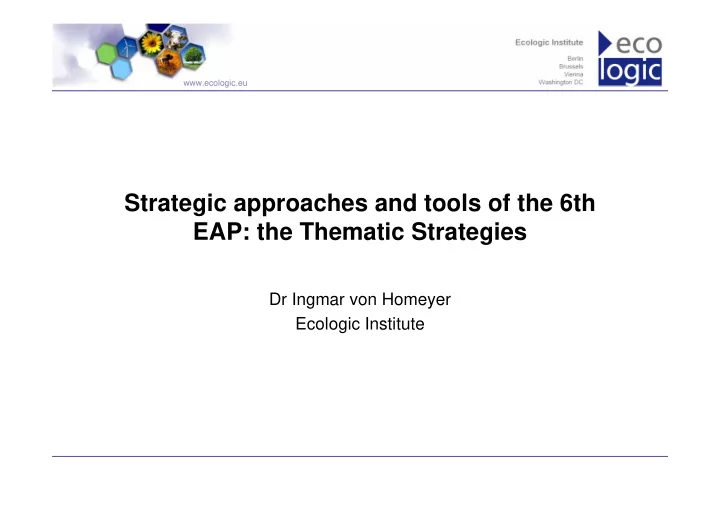

www.ecologic.eu Strategic approaches and tools of the 6th EAP: the Thematic Strategies Dr Ingmar von Homeyer Ecologic Institute
www.ecologic.eu The Thematic Strategies as a „tool“ in the 6EAP Article 4 6EAP: Actions in Articles 5 to 8 shall include the development of thematic strategies and the evaluation of existing strategies for priority environmental problems requiring a broad approach. According to Article 4 6EAP, the thematic strategies: ‘should include an identification of the proposals that are required to reach the objectives set out in the Programme and the procedures foreseen for their adoption’; ‘may include...relevant qualitative and quantitative environmental targets and timetables against which the measures foreseen can be measured’; ‘should be developed and implemented in close consultation with the relevant parties’; and ‘should be presented to the European Parliament and the Council within 3 years of the adoption of the Programme at the latest’; development and implementation of the strategies. 2
www.ecologic.eu Seven Thematic Strategies Thematic Strategies were foreseen in the 6EAP and subsequently adopted in the following areas: air pollution marine environment natural resources soil pesticides urban environment waste. 3
www.ecologic.eu Important effects The Thematic Strategies encouraged an open debate on relatively comprehensive fields of EU environmental policy prior to the legislative process engaged stakeholders from different sectors and Commission DGs enabled improvement of the knowledge base In some cases enabled an extension of the EU environmental agenda into sensitive areas (because of subsidiarity concerns or strategic significance) Through network building Sometimes also through framework legislation (marine, perhaps soil) 4
www.ecologic.eu Time and resources Extensive consultations and the process of preparing the Thematic Strategies consumed a considerable amount of time and resources, in particular in the first years of the 6EAP Eventually, these costs were at least partly compensated for by the fact that in the majority of cases the Commission developed and adopted concrete legislative measures together with the Thematic Strategies Once the thematic strategies were adopted, additional time and resources were required to adopt the associated legislation (if there was associated legislation) 5
www.ecologic.eu Targets and timetables While a key rationale behind the co-legislator’s original idea for the Thematic Strategies was to discuss possibilities for setting quantifiable targets, the Thematic Strategies frequently contained only vaguely formulated goals and timeframes. In many cases the detailed definition of specific objectives and measures was further postponed, or left to the Member States. However, it remains an open question whether setting concrete targets in the 6EAP would have been more successful. Where the 6EAP formulated a relatively concrete objective, i.e. for air pollution, this was revised downwards in the process of formulating the Thematic Strategy. 6
www.ecologic.eu Effectiveness of the Thematic Strategies The experience with the Thematic Strategies suggests that it is difficult to assess their effectiveness in general because they faced different challenges and pursued different purposes. For example, in some cases the Thematic Strategies had a significant influence on the adoption of important Commission proposals, such as the Marine Strategy Framework Directive and the proposal for the Soil Directive, other strategies resulted in more limited measures - the Natural Resources and Urban Environment Thematic Strategies; prepared, and allowed for, an extension of EU environmental policy into politically sensitive areas (marine, urban, spoil, resources) – albeit legally non-binding or highly flexible measures; updated existing measures, aimed at improving their coherence, and filled certain gaps (air, waste, pesticides). 7
www.ecologic.eu Variation in causal factors Factors shaping the Thematic Strategies also differed widely among the Strategies. Important factors included the findings of the impact assessment and scientific input (air pollution) effective co-ordination with stakeholders (marine environment) better regulation and the Co-decision Procedure (waste) conceptual and methodological problems, lack of political interest (resources) resistance from some stakeholders (urban environment) 8
www.ecologic.eu Conclusions with respect to potential 7EAP Should a potential 7EAP include Thematic Strategies? Thematic Strategies benefited from inclusion in 6EAP in at least two main ways: In the fact of strong political opposition, the Thematic Strategies benefited from the fact that they were key elements of the 6EAP. The fact that the 6EAP was adopted through the Co-decision Procedure is likely to have been relevant in this context, too; Argueably, despite late adoption of the Thematic Strategies, the common deadline in the 6EAP helped to accelerate the process of developing them. If so, which new strategies and why? The existing strategies are being reviewed. New strategies co-owned by different sectors to promote development of the green economy? 9
www.ecologic.eu Thank you for your time. Any questions? Ingmar von Homeyer Ecologic Institute, Pfalzburger Str. 43-44, D-10717 Berlin Tel. +49 (30) 86880-0, Fax +49 (30) 86880-100 ingmar.homeyer{at}ecologic{dot}eu www.ecologic.eu 10
Recommend
More recommend